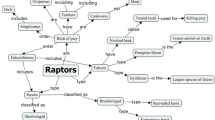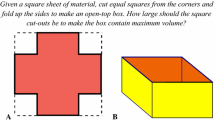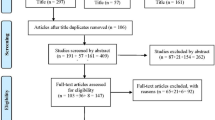Abstract
This study investigated the effect of an innovative method for presenting coordinate definitions on learning defined concepts. A text that arranged definitions and examples of seven coordinate concepts in a tree-like diagram was contrasted with a text that arranged these same definitions and examples in a standard textbook format. In addition, this study examined a method of creating concept examples that required different levels of discrimination and generalization, called a rational set generator. Forty-six junior and senior high school physics students participated. Results confirmed the predicted interaction between text method and reading ability, with the lower ability students benefiting more from the diagram method than their counterparts exposed to the textbook format.
Similar content being viewed by others
References
Anderson, J. R. (1976).Language, memory and thought. New Jersey: Erlbaum.
Anderson, R. C. (1973). Learning principles from text.Journal of Educational Psychology, 64, 26–30.
Bower, G. (1970). Organizational factors in memory.Cognitive Psychology, 1, 18–46.
Gagne, E. D. (1978) Long-term retention of information following learning from prose.Review of Educational Research, 48 629–665.
Gagne, R. M. (1977).The conditions of learning (3rd ed.). New York: Holt, Rinehart and Winston.
Gagne, R. M., & Briggs, L. J. (1979).Principles of instructional design (2nd ed.). New York: Holt, Rinehart and Winston.
Klatzky, R. L. (1980).Human memory: Structures and processes (2nd ed.). San Francisco: William H. Freeman & Co.
Klausmeier, H. J., Ghatala, E. S., & Frayer, D. A. (1974).Conceptual learning and development: A cognitive view. New York: Academic Press.
Landa, L. (1974).Algorithimization in learning and instruction. Englewood Cliffs, NJ: Educational Technology Publications.
Merrill, M. D., Reigeluth, C. M., & Faust, G. W. (1979). The instructional quality profile: A curriculum evaluation and design tool. InProcedures for instructional systems development. New York: Academic Press.
Markle, S. M. (1975).They teach concepts, don't they? Invited address to the American Educational Research Association.
Markle, S. M. (1977). Teaching conceptual networks.Journal of Instructional Development, 1, 13–17.
Markle, S. M., & Tiemann, P. (1969).Really understanding concepts, or in fruminous pursuit of the jabberwock. Chicago: Tiemann Associates.
Park, O. (1984). Example comparison strategy versus attribute identification strategy in concept learning.American Educational Research Journal, 21(1), 145–162.
Reigeluth, C. M., & Stein, F. S. (1983). The elaboration theory of instruction. In C. M. Reigeluth (Ed.),Instructional design theories and models. Hillsdale, NJ: Lawrence Erlbaum.
Reiser, R. A., & Gagne, R. M. (1982) Characteristics of media selection models.Review of Educational Research, 52(4), 499–513.
Shavelson, R. J. (1972). Some aspects of the correspondence between content structure and cognitive structure on physics instruction.Journal of Educational Psychology, 63, 225–234.
Tennyson, R. D. (1980). Instructional control strategies and content structure as design variables in concept acquisition using computer-based instruction.Journal of Educational Psychology, 72(4), 525–532.
Tennyson, R. D., & Boutwell, R. C. (1974). Methodology for the sequencing of instances in classroom concept teaching.Educational Technology, 14, 45–49.
Tennyson, R. D., Chao, J. N., & Younger, J. (1981). Concept learning effectiveness using prototype and skill development presentation forms.Journal of Educational Psychology, 73, 326–334.
Tennyson, R. D., & Park, S. I. (1984). Process learning time as an adaptive design variable in concept learning using computer-based instruction.Journal of Educational Psychology, 76(3), 452–465.
Tennyson, R. D., Woolley, F. R., & Merrill, M. D. (1972). Exemplar and nonexemplar variables which produce correct concept classification behavior and specified classification errors.Journal of Educational Psychology, 62, 144–152.
Wilcox, W. C., Merrill, M. D., & Black, H. B. (1981). Effect of teaching a conceptual hierarchy on concept classification performance.Journal of Instructional Development, 5(1), 8–13.
Woolley, F. R., & Tennyson, R. D. (1972). Conceptual model of classification behavior.Educational Technology, 12, 37–40.
Author information
Authors and Affiliations
Rights and permissions
About this article
Cite this article
Tessmer, M., Driscoll, M.P. Effects of a diagrammatic display of coordinate concept definitions on concept classification performance. ECTJ 34, 195–205 (1986). https://doi.org/10.1007/BF02767401
Issue Date:
DOI: https://doi.org/10.1007/BF02767401




